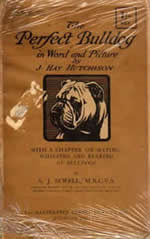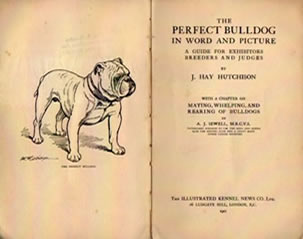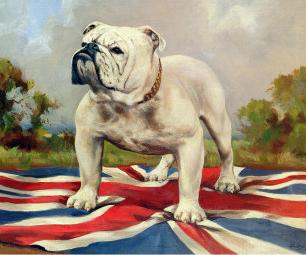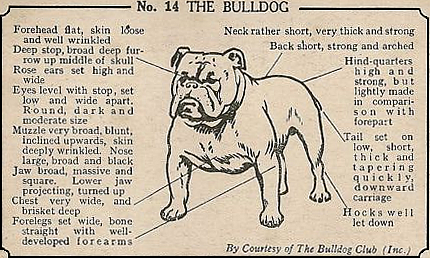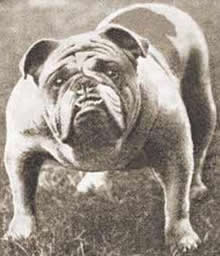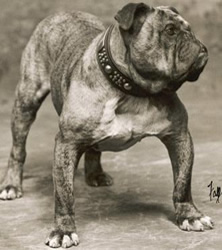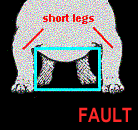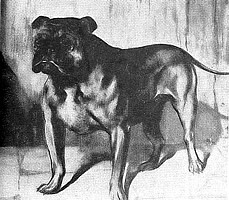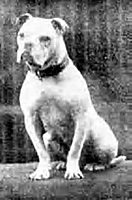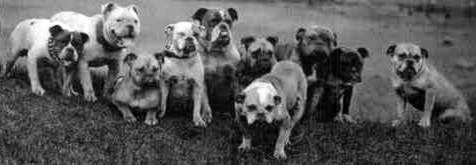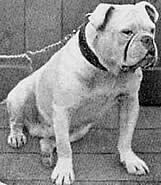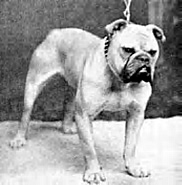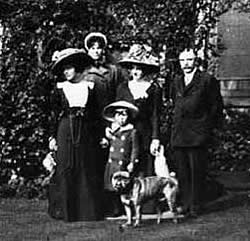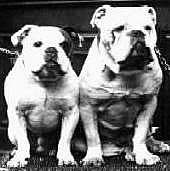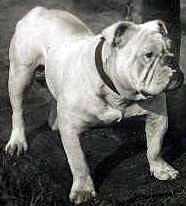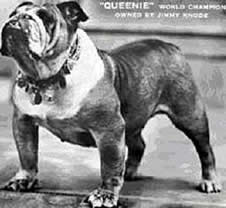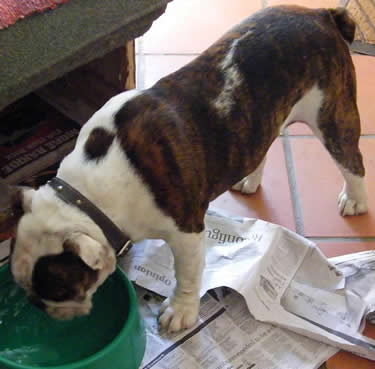

|
||||||||
| Perfect English Bulldog An ideal may be viewed as an idea we have or, perhaps more realistically, as a standard that we ourselves have constructed. We may grant, with Plato, that no actual English Bulldog will ever be an absolutely perfect specimen of the breed, no matter how much time and effort bulldog fanciers may expend in attempting to realise their ideal. There is absolutely no reason to suppose that the ideal standard for the breed that we may picture to ourselves or express in words amounts to a transcendent entity to which actual bulldogs are somehow related. (Bruce Aune, Metaphysics: The Elements, Univ Minnesota Press, 1985) |
||||||||
| I am sure that everyone’s idea of the Perfect Bulldog differs to some degree. My wife, Lettie, likes the look of the modern, low-slung monster of the championship shows. I do too, but only as a curiosity. On the other hand, we both believe that our Humphrey is as near perfect as any currently living bulldog can be, and I guess the same applies to many, if not most owners of bulldogs. Of course, in reality, some must be better specimens than others, but what intrinsic qualities make this so? I have some controversial views that may seem to be-self-serving, to elevate my own dogs perhaps, but this is not my primary motivation and any result to this effect is purely serendipitous. What follows is the illustration from J. Hay Hutchison’s “The Perfect Bulldog in Word and Picture; A Guide for Exhibitors, Breeders and Judges (Illustrated Kennel News, London, 1908): | ||||||||
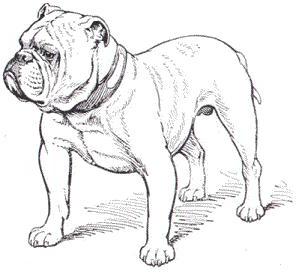 |
||||||||
Though
I personally, for reasons of my own sense of aesthetics and also
evidence-based substantiation, consider the dog in the photo below
to represent the ideal of the Perfect Bulldog, I am nevertheless,
given the extreme degree to which breeders have strayed from the
ideal, as a maximum compromise of my own conviction, willing to
accept the above illustration as representing the ideal of a modern
‘perfect bulldog’.
For the English bulldog and fraternity to regain it’s integrity, there needs to be not the selfish rejection of the U.K. Kennel Club’s revised Standard as witnessed to date, but rather a generous reformational consolidation around an authentic reference specimen representing the pinnacle of mankind’s breeding of what once was the finest dog breed in the world (which no-one can today claim of the show-class bulldog). I humbly propose that Hutchison’s illustration be that authentic specimen, signalling a directional change from disaster to a return to the glory days of the English bulldog, which may take a couple, rather than several decades to achieve, if breeders fully utilise the dwindling authentic gene pool to this noble end, with exaggeration away from the current fashion in the direction of my preferred photo candidate below. My ultimate wish for bulldogs the world over would be a dedicated reverse-engineering trend amongst bulldog breeders, ultimately akin to time-travel back to the bulldogs as they were during the golden fifty-year period between the formalisation of the first Bulldog Club standards in the last quarter of the 19th century and the strongly Hutchison-influenced first quarter of the 20th (i.e. the Victorian & Edwardian eras). |
||||||||
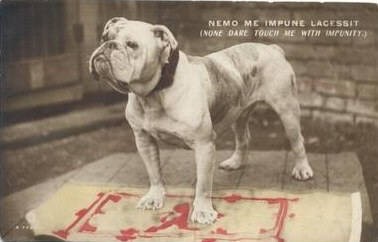 |
||||||||
| My preferred candidate for Perfect English Bulldog, circa 1900. | ||||||||
| The motto, “None dare provoke me with impunity” is Scottish. | ||||||||
| Among Bulldog fanciers much stress is laid upon what – for want of a better word – is called “sourness” as a desirable quality in the expression, described as the sourness of ‘aloofness’, rather than of ill-temper, a sourness that in the human being would probably be describes as ‘haughtiness’. A word more expressive of this quality is the Scotticism “dourness”, which comprehends in its meaning determination as well as “sourness”, and is the very antithesis of all fawning and “gush”. It is well that this sourness is considered an important quality in the expression, for if rightly understood, it is equivalent for courage, determination, tenacity and, incidentally, of strength in the expression, and should rank as the dominant quality. | ||||||||
 |
||||||||
| Humphrey has been blessed with that expression of ‘dourness’. | ||||||||
The
original Bulldog Club’s standard, titled “The
‘British’ Bulldog”, authored by
Samuel Wickens and signed under the pseudonym ‘Philo-Kuon’
(Latin for dog-lover), in London, February 1865, in its preface,
stated as follows:
“The British Bulldog is a majestic, ancient animal, very scarce, much maligned and as a rule, very little understood. ……….. This noble dog becomes degenerate abroad – in truth he is a national animal, and is perfectly identified with old England – and he is a dog of which Englishmen may be proud.” The Bulldog Club Incorporated’s 1875 and
by extension the most recent evolution of their (the official international)
Bulldog Standard (following a few minor - with the exception of
the weight increase - amendments over more than a century) is responsible
for the morphological health problems afflicting modern bulldogs,
due to the idealistic wording therein that encouraged ongoing exaggerations
over 135+ years, intended to distance their member’s dogs
from the working bulldogs to make them more socially and commercially
desirable as flashy conformation show dogs and as softer domestic
pets. Clearly they have succeeded in creating something that did
not exist before. |
||||||||
 |
||||||||
The
current fashionable interpretation was and still is a serious deviation
from the original vision of the Bulldog Club Incorporated, which
still pays lip service to Hutchison’s Perfect Bulldog illustration.
Besides using the image in its logo banner, it also sells reprints
of the book, their only offering on the subject, stating that it
“details all the points of a bulldog – good and bad
– and is invaluable for anyone breeding and showing.”
I say ‘lip service’ because, few, if any of the dogs
awarded at its championship shows conform to Hutchison’s illustration.
All are overweight, have legs and bodies that are too short and
they have no classic slim lightweight waist, nor a near square between
their too short forelegs. |
||||||||
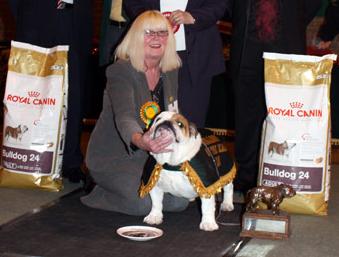 |
||||||||
| The Bulldog Club’s
champions are overweight and too short. Compare with the perfect bulldog illustrated in their banner. |
||||||||
| The cover and frontice page illustrations from Hutchison’s book, accessible hereunder and which represented the perfect bulldog, was published from 1908 to at least 1916 (7th Edition), with a reprint in 1977 and subsequently. This treatise, in my opinion, the most sober, accurate and comprehensive during its time and ever since, became available during the Edwardian era, 35-years after the Bulldog Club Inc. published its Bulldog Standard, but unfortunately, failed to maintain his intended restraint over the exaggeration-focussed bulldog breeding fraternity. Had his illustrations been duly incorporated into the Standard, we might not have the crisis facing bulldogs today. | ||||||||
|
||||||||
| Shortly after publication of Hutchison’s treatise and having had an authoritative guiding influence on the English bulldog breeding fraternity for several years, the advent of the breakout of the First World War served to prevent too much further harm being done to the breed during that period. During WW1, the ‘English’ Bulldog for a while again became the ‘British’ Bulldog, a symbol of Great Britain’s courage, tenacity, resilience, determination and fighting spirit when faced with aggression. It is a pity that Hutchison’s fine conformation influence was not more so. | ||||||||
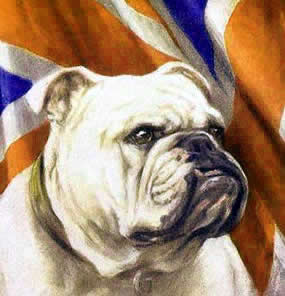 |
||||||||
J Hay
Hutchison, wrote in the preface to his original 1908 1st Edition
of his ‘The Perfect Bulldog’ as follows:
“In
this work I have attempted to present the various defects in modern
Bulldogs by pictorial diagrams in a way that will be readily understood,
and have placed other diagrams showing the ideal points as laid
down in the descriptions and Standards of the several Bulldog Clubs
alongside them. Whilst most authorities are agreed on the subject
in theory, their interpretations are as diverse as those of art
critics, largely due to the fact that works on the Bulldog have
hitherto been confined to written descriptions and discussions,
without the necessary illustrative sketches to show the points in
a clear and unmistakable manner. I believe my sketches will demonstrate
not only the defects, but also the actualities desired in this noble
breed.” |
||||||||
 |
||||||||
| “My study of the Bulldog, which has extended over twenty years, has led me to the conclusion that the perfect Bulldog of today should be the embodiment, in appearance at least, of the activity, strength and endurance that go to make a dog capable of bull-baiting, even though it is not called upon to exhibit its prowess in the field. The old sport of baiting bulls and bears has been stamped out and the Bulldog itself would have become extinct but for its enthusiastic fanciers. That it still retains its old historic instincts is, however, not doubted by those thoroughly conversant with the subject and modern instances of its capabilities when aroused and plentiful.” | ||||||||
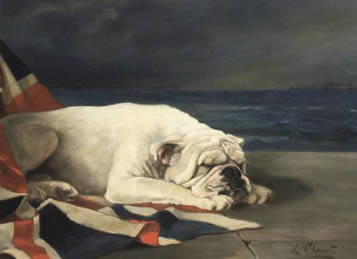 |
||||||||
| “The scientific efforts which have been brought to bear on its breeding have made the ideal Bulldog quite capable as his predecessors. The only element lacking is that of training for its special kind of work, and disuse means temporary unfitness. But the present day Bulldog’s wide chest, short nose and light hindquarters have all their obvious meaning, and its qualities of dour, determined pluck are indubitable. The ideal Bulldog I have tried to portray is the symmetrical, well-proportioned and active dog, free from exaggeration and monstrosity.” “I shall be glad if my illustrations lead to a more clearly defined knowledge of the essential points to be looked for in the perfect specimen, and of the faults to be avoided.” J Hutchison End quote |
||||||||
| The precedent of using the ‘British’ bulldog as a symbol of national pride was somewhat repeated during WW2. The ongoing devolution of the English bulldog from that of the traditional golden era to the end of WW1 in just another quarter of a century up to WW2 is clearly evident in the Second World War flag paintings below. | ||||||||
|
||||||||
| Much of the troubles afflicting modern and especially show bulldogs is as a result of its having been vigorously crossed with the Chinese Pug between the middle and late 1800’s (just how ‘English’ is that?). This allowed a quick change in the shape and size away from the working dogs of the prior quarter of that century and led to the creation of most of the monsterism evident today. The two photos below illustrate just how monstrous the results were (and they still are evident in the fashionable shape and look of today). Both photos are the earliest we have on record of extreme monsterism in bulldogs, which unfortunately ran parallel with more conventional looks of that period and eventually nearly altogether consumed the traditional bulldog features, leaving us with the but a few gems left carrying the genes of more traditional riff-raff Humphrey-type real English bulldogs. | ||||||||
|
||||||||
| Modern show bulldogs are by their own Standards, too short in the legs and grossly in excess of the maximum 25kgs and 23kgs for dogs and bitches respectively, in spite of having lost both length of body and limb to breeding. These poor animals, from my own observations and experience, have a tendency to be and often are medically obese, putting great strain on their cardiovascular system and commonly succumbing prematurely to heart failure. They spend their lives breathing with even greater difficulty than non-pedigreed and less-pedigreed bulldogs, panting with their tongues hanging out without even having undergone any exertion other than holding their hefty mass aloft, and as can be clearly observed with Champion Whitefoam below, this champion is in distress. | ||||||||
England’s
Champion Pressgang, left above, was at the turn of that century
hailed as a leading pillar of the breed, a perfect example of the
English National Dog and was and still is considered by English
Bulldog historians as one of the most noted bulldogs in history.
I personally have to concur that Pressgang must be one of the finest
specimens ever. |
||||||||
|
||||||||
| Earlier bulldogs were bred for form and function and in particular, for agility and in no way resembled the seal-like show dogs of today, who as a result of their restrictive exaggeration-driven-bred morphology, are relatively unfit and incapable of running and jumping effortlessly, which is surely, by majority view, every dog’s fundamental right. The trend to breed dogs to be as low to the ground as possible started with those bred for dogfights, where it was intended that the soft underside of the body be made less vulnerable to fatal organ wounds. It was not until the rise of dog shows in the late 1800s that breeders more generally selected for the current trend, now taken to excess. Personally, I believe Humphrey is an excellent compromise between the extremes shown both above and below. | ||||||||
 |
||||||||
| Humphrey of Bygones. An excellent transitional compromise between the post-Victorian and current show dog extremes. Indeed, the owner and author, considers this to be one of, if not “the” finest ‘fit for function’ male Bulldog(s) alive today….period | ||||||||
I believe no-one had
the right to whittle away their traditionally substantial legs down
to mere stumps over the years, without their informed consent. It
was bad enough that the body length and tails were taken, but legs,
those things are really useful, like for really running and really
jumping. My appeal to breeders is to change course now and work
in earnest to return the bulldogs legs! According to a specialist
in canine genetics and anatomy, it is possible for a purebred English
bulldog to grow taller than the breed standard, since they still
variably carry genes of their long-legged ancestors. (Coile
DC, PhD, Encyclopedia of Dog Breeds, Barrons, 2005) |
||||||||
| It is time to really
put the dogs first. The English bulldog’s originating country
and hence it’s international authority, the U.K. Kennel Club,
is firm in its resolve to enforce the revised standards and has reiterated
its position that: “There is absolutely no question
that a dog should be able to see, breathe and walk freely and that
it should be fit enough to have the ability to perform its original
function. The final Standards make it clear to all that the exaggeration
of features for aesthetic reasons, when this is to the detriment of
a dog’s health, is unacceptable. All judges will be expected
to use the revised Standards from October." I say
Bravo, bravo!
IN CELEBRATION OF THE BULLDOG’S LEGS We have selected a time-capsule of bulldog photos from our archives to celebrate the English bulldog and in particular, its legs. As foreleg length diminished with ill-conceived selection over time, so did the health and welfare of the Bulldog, resulting in the pathetic crippled dwarfs as exemplified by the showdogs of today. The latest Bygones Bulldogs breeding acquisition which will be used to attempt to reverse this phenomenon in our Bulldogs is shown below the gallery in the form of Lady Becci, who promises to minimize facial wrinkles and the over-nose-roll, and emphasize improved foreleg length and overall original Bulldog morphology that existed prior to the disastrous crossings with the Pug. |
||||||||
|
||||||||||||||||||||||||||||||||||||||||||||||||||||||||||||||||||||||
| For more discussion around the Perfect Bulldog, see also our home page here. |
For more discussion around the authentic Bulldog, see also our Lectures page here. |
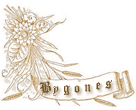 |
Bygones Bulldogs is copyright © 2009. Bygones Bulldogs all rights reserved |
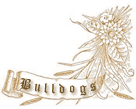 |
